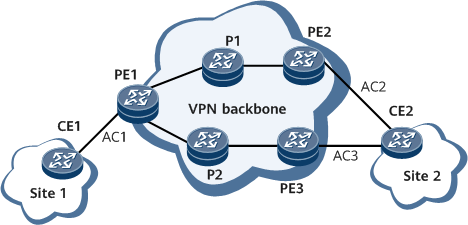(Optional) Configuring a Secondary VPWS PW
This section describes how to configure a secondary VPWS PW for VLL FRR, so that L2VPN traffic can be quickly switched to the secondary path if the primary path fails. After the primary path recovers, the L2VPN traffic can be switched back to it according to the corresponding revertive switching policy.
Context
A secondary VPWS PW is mainly used in the following networking modes:
CEs symmetrically dual-homed to PEs
Two communication paths exist between the CEs on the two ends of the VC. One is the primary PW path, and the other is the secondary PW path.
CEs asymmetrically connecting to PEs
On the network shown in Figure 1, a pair of primary and secondary PWs need to be configured on PE1. Only one PW needs to be configured on PE2 and PE3. Therefore, the two PEs do not determine whether the PW is a primary or secondary PW.
The CE on one end of the VC accesses a higher-reliability PE over a single reliable link. The CE on the other end is dual-homed to lower-reliability PEs. The two CEs can communicate over two paths. The higher-reliability path serves as the primary path, and the lower-reliability path serves as the secondary path.
In the networking where CEs asymmetrically connect to PEs, you need to configure both primary and secondary PWs. The primary and secondary PWs must be of the same type.
In the scenario where CEs asymmetrically connect to PEs, the interface used by the singled-homed CE to connect to the corresponding PE requires both primary and secondary IP addresses. When the primary path is available, the CE uses the primary IP address to communicate with the remote CE. When a fault occurs on the primary path, this CE uses the secondary IP address to communicate with the remote CE.

On a network where CEs asymmetrically connect to PEs, the secondary PW does not transmit data when the primary and secondary paths both work properly. If the secondary PW AC interface borrows the IP address of the primary PW AC interface, the following situations arise:
Non-revertive switching cannot be configured.
The local CE has two equal-cost direct routes to the remote CE, with both routes having the same destination address and same next hop. The route that passes through the secondary PW is actually an invalid route.
If CEs exchange routing information using routing protocols, you need to change the cost or metric of the secondary path AC interface to be greater than that of the primary path AC interface. In this case, the local CE may fail to communicate with the remote CE, but can communicate with other user devices on the remote end.
If CEs use static routes to exchange routing information, ensure that the preference of the backup route is lower than that of the primary route (a larger value indicates a lower preference). To do so, run the ip route-static dest-ip-address mask out-interface preference preference-value command.
Perform the following steps on the PE to which a CE is single-homed:
Procedure
- Run system-view
The system view is displayed.
- Run mpls l2vpn
MPLS L2VPN is enabled.
- Run quit
Return to the system view.
- Run interface interface-type interface-number [ .subinterface-number ]
The AC interface view is displayed.
- Run one of the following commands to create a secondary VPWS PW according to the interface type:
Ethernet interface:
mpls l2vc { ip-address | pw-template template-name } * vc-id [ access-port | [ control-word | no-control-word ] | ignore-standby-state | [ raw | tagged ] | tunnel-policy policy-name [ endpoint endpoint-address color color-value ] | secondary ]*
During the configuration of a secondary VPWS PW, it is recommended that the same parameter settings be applied to the primary, secondary, and bypass PWs. Parameter setting inconsistency will cause the secondary or bypass PW to fail to take over traffic if the primary PW fails.
In the scenario where CEs asymmetrically connect to PEs, note the following:
- Only the PE to which a CE is single-homed requires the configuration of both the primary and secondary PWs. The PEs to which CEs are dual-homed require only the configuration of the primary PW.
- The control word configurations for the primary and secondary PWs must be the same. Otherwise, a large number of packets will be lost after a primary/secondary PW switchover.
- (Optional) Run undo interface-parameter-type vccv
The VCCV byte (an interface parameter) is deleted from the Label Mapping message.
Run this command if LDP VPWS is configured for a device running VRP V800R005 or later and this device communicates with another device running VRP V300R001 or any branch version of VRP V300R001.
- (Optional) Run mpls l2vpn service-name service-name
An L2VPN service name is specified. The L2VPN service can then be maintained through an NMS based on the specified name.
- Run commit
The configuration is committed.
